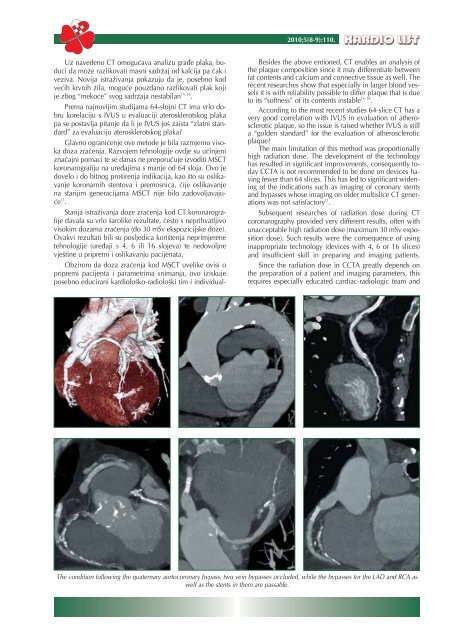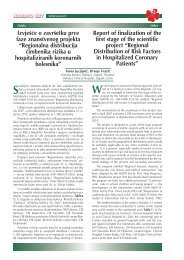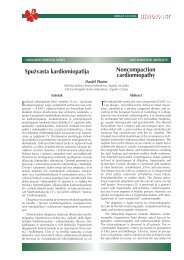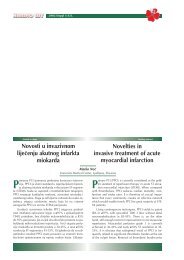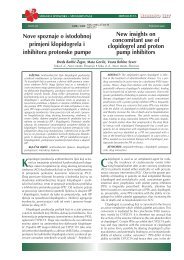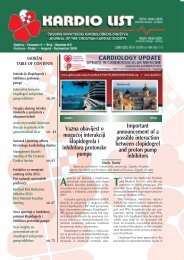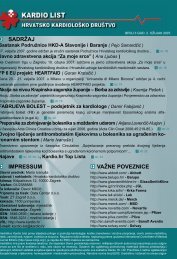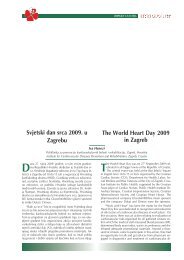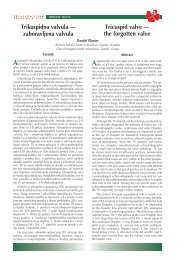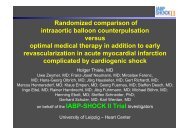stranica / page 106-112 - Kardio.hr
stranica / page 106-112 - Kardio.hr
stranica / page 106-112 - Kardio.hr
You also want an ePaper? Increase the reach of your titles
YUMPU automatically turns print PDFs into web optimized ePapers that Google loves.
2010;5(8-9):110.<br />
Uz navedeno CT omoguÊava analizu graapplee plaka, buduÊi<br />
da moæe razlikovati masni sadræaj od kalcija pa Ëak i<br />
veziva. Novija istraæivanja pokazuju da je, posebno kod<br />
veÊih krvnih æila, moguÊe pouzdano razlikovati plak koji<br />
je zbog “mekoÊe” svog sadræaja nestabilan 14, 16 .<br />
Prema najnovijim studijama 64-slojni CT ima vrlo dobru<br />
korelaciju s IVUS u evaluaciji aterosklerotskog plaka<br />
pa se postavlja pitanje da li je IVUS joπ zaista “zlatni standard”<br />
za evaluaciju aterosklerotskog plaka?<br />
Glavno ograniËenje ove metode je bila razmjerno visoka<br />
doza zraËenja. Razvojem tehnologije ovdje su uËinjeni<br />
znaËajni pomaci te se danas ne preporuËuje izvoditi MSCT<br />
koronarografiju na ureappleajima s manje od 64 sloja. Ovo je<br />
dovelo i do bitnog proπirenja indikacija, kao πto su oslikavanje<br />
koronarnih stentova i premosnica, Ëije oslikavanje<br />
na starijim generacijama MSCT nije bilo zadovoljavaju-<br />
Êe 11 .<br />
Starija istraæivanja doze zraËenja kod CT koronarografije<br />
davala su vrlo πarolike rezultate, Ëesto s neprihvatljivo<br />
visokim dozama zraËenja (do 30 mSv ekspozicijske doze).<br />
Ovakvi rezultati bili su posljedica koriπtenja neprimjerene<br />
tehnologije (ureappleaji s 4, 6 ili 16 slojeva) te nedovoljne<br />
vjeπtine u pripremi i oslikavanju pacijenata.<br />
Obzirom da doza zraËenja kod MSCT uvelike ovisi o<br />
pripremi pacijenta i parametrima snimanja, ovo iziskuje<br />
posebno educirani kardioloπko-radioloπki tim i individual-<br />
Besides the above entioned, CT enables an analysis of<br />
the plaque composition since it may differentiate between<br />
fat contents and calcium and connective tissue as well. The<br />
recent researches show that especially in larger blood vessels<br />
it is with reliability possible to differ plaque that is due<br />
to its “softness” of its contents instable 14, 16 .<br />
According to the most recent studies 64-slice CT has a<br />
very good correlation with IVUS in evaluation of atherosclerotic<br />
plaque, so the issue is raised whether IVUS is still<br />
a “golden standard” for the evaluation of atherosclerotic<br />
plaque?<br />
The main limitation of this method was proportionally<br />
high radiation dose. The development of the technology<br />
has resulted in significant improvements, consequently today<br />
CCTA is not recommended to be done on devices having<br />
fewer than 64 slices. This has led to significant widening<br />
of the indications such as imaging of coronary stents<br />
and bypasses whose imaging on older multislice CT generations<br />
was not satisfactory 11 .<br />
Subsequent researches of radiation dose during CT<br />
coronarography provided very different results, often with<br />
unacceptable high radiation dose (maximum 30 mSv exposition<br />
dose). Such results were the consequence of using<br />
inappropriate technology (devices with 4, 6 or 16 slices)<br />
and insufficient skill in preparing and imaging patients.<br />
Since the radiation dose in CCTA greatly depends on<br />
the preparation of a patient and imaging parameters, this<br />
requires especially educated cardiac-radiologic team and<br />
The condition following the quaternary aortocoronary bypass, two vein bypasses occluded, while the bypasses for the LAD and RCA as<br />
well as the stents in them are passable.


